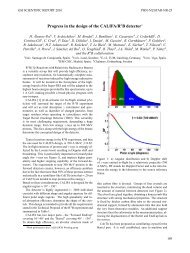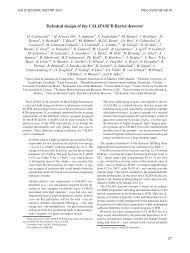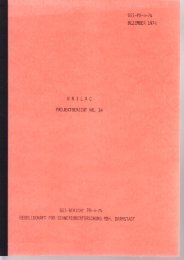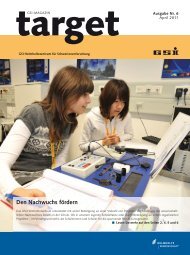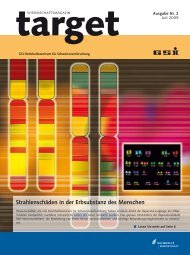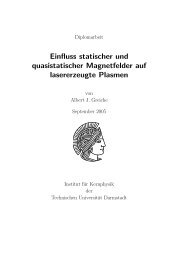download block - GSI Helmholtzzentrum für Schwerionenforschung
download block - GSI Helmholtzzentrum für Schwerionenforschung
download block - GSI Helmholtzzentrum für Schwerionenforschung
Create successful ePaper yourself
Turn your PDF publications into a flip-book with our unique Google optimized e-Paper software.
ACC-OTHERS-01 <strong>GSI</strong> SCIENTIFIC REPORT 2009<br />
tion. Finally, the design value of 8.0 keV/u was kept.<br />
Transmissions along the RFQ up to 60 % were reached<br />
for H3 + as well as for C 4+ beams for matched injection.<br />
For a detailed summary of RFQ commissioning results<br />
see Ref. [8].<br />
420<br />
415<br />
410<br />
405<br />
400<br />
395<br />
H3+ - full - 8.0keV/u<br />
H3+ - probe - 8.0keV/u<br />
H3+ - full - 8.5keV/u<br />
H3+ - probe - 8.5keV/u<br />
C4+ - full - 8.0keV/u<br />
390<br />
4.4 4.5 4.6 4.7 4.8 4.9 5.0 5.1 5.2 5.3 5.4<br />
tank voltage [V]<br />
Figure 3: RFQ output beam energy in keV/u as function<br />
of the scaled tank voltage for different ion beams<br />
IH Linac<br />
More than 140 measurement series including numerous<br />
amplitude and phase scans were performed with the IH<br />
linac. Different LEBT beam energies, RFQ settings, and<br />
IH tank plunger configurations were investigated. The<br />
linac was optimized with respect to high beam transmission,<br />
minimum beam emittances and optimized bunch<br />
signal amplitudes. For the final setting, the measured<br />
linac beam energy amounts to 7.2 MeV/u at a RF pulse<br />
power of 910 – 930 kW.<br />
Table 2: Typical beam currents and linac transmission<br />
Ion<br />
Species<br />
C 4+ / C 6+<br />
H 3 + / p<br />
Beam Current / µA Linac Trans-<br />
LEBT Linac Stripped mission<br />
~170 ~80 115 48 %<br />
1100 400 1200 39 %<br />
710 307 900 46 %<br />
Figure 4: Measured C 4+ / C 6+ beam pulses<br />
Table 2 summarizes typical beam currents achieved at<br />
the LEBT upstream of the solenoid focusing into the<br />
RFQ, behind the IH linac, and behind the stripping foil.<br />
160<br />
LEBT: 169 µA<br />
Linac: 85.9 µA<br />
Stripped: 116 µA<br />
Fig. 4 shows examples of measured beam pulses. A total<br />
linac transmission (incl. solenoid, RFQ, and IH linac) up<br />
to 48 % was achieved, meeting the design beam currents<br />
behind the stripper (100 – 120 µA for C 6+ and 700 µA for<br />
protons) and even exceeding them.<br />
The quadrupole settings behind the linac were optimized<br />
to achieve minimum beam diameters at the stripping<br />
foil in order to reduce emittance growth effects in<br />
the foils. Measured beam emittances for the final settings<br />
are listed in Table 3 and are shown in Fig. 5. Twiss parameters<br />
are similar in both transverse planes.<br />
Figure 5: Hor. (left) and ver. (right) proton beam emittances<br />
measured ~1 m behind the stripping foil<br />
Table 3: Measured beam emittances (4 × rms for 90 % of<br />
the beam current) behind the stripping foil and emittance<br />
growth in the foil<br />
Ion<br />
Species<br />
ε 4×rms, 90% / π mm mrad<br />
horizontal vertical<br />
Emittance Growth<br />
hor. ver.<br />
C 6+ 3.6 3.0 6 % 6 %<br />
protons 4.7 4.7 15 % 40 %<br />
Summary and Outlook<br />
Commissioning and beam tests of all components delivered<br />
and supervised, respectively, by <strong>GSI</strong> were accomplished<br />
successfully in 2009. Design beam currents were<br />
achieved and even exceeded; the measured beam emittances<br />
agree well with expected values. Finally, twenty<br />
CNAO operators, engineers and physicists were trained in<br />
linac operation by <strong>GSI</strong> in November 2009 – marking the<br />
end of the <strong>GSI</strong> services fixed in the CNAO-<strong>GSI</strong> contract.<br />
Acknowledgements<br />
The authors wish to thank the numerous <strong>GSI</strong> colleagues<br />
involved in this project over the past years. Their efforts<br />
are greatly acknowledged. Many thanks to all CNAO and<br />
INFN collaborators for the fruitful cooperation, the cordial<br />
atmosphere and the great hospitality at CNAO.<br />
References<br />
[1] S. Rossi, EPAC 2006, p. 3631.<br />
[2] B. Schlitt, LINAC08, p. 720.<br />
[3] B. Schlitt et al., <strong>GSI</strong> Scientific Report 2006, p. 383.<br />
[4] A. Reiter et al., EPAC 2006, p. 1028.<br />
[5] H. Vormann et al., EPAC08, p. 1833.<br />
[6] B. Schlitt et al., <strong>GSI</strong> Scientific Report 2008, p. 409.<br />
[7] E. Bressi et al., PAC09, TU6PFP005.<br />
[8] P. Posocco et al., HIAT09, in print.





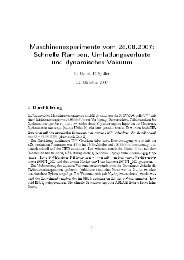
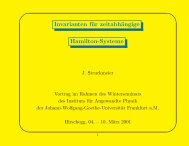
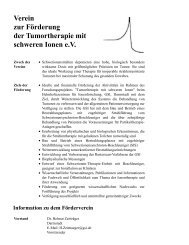
![GS I -P-]-17 - GSI Helmholtzzentrum für Schwerionenforschung](https://img.yumpu.com/20698964/1/184x260/gs-i-p-17-gsi-helmholtzzentrum-fur-schwerionenforschung.jpg?quality=85)

